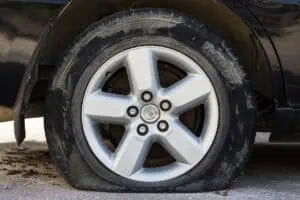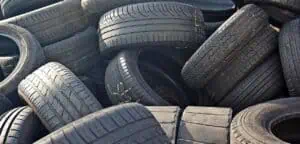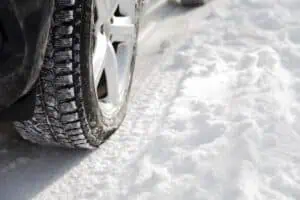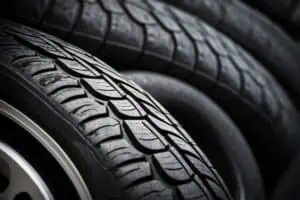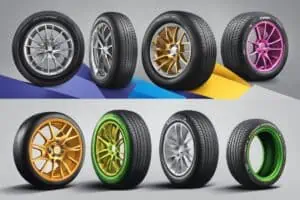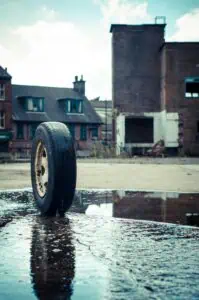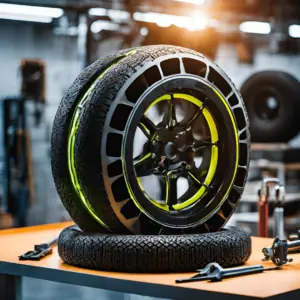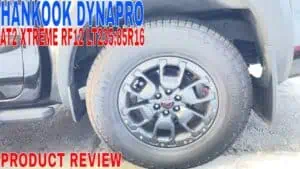As we’ve had the opportunity to dive deep into the world of run-flat tires, we’ve uncovered some fascinating insights that we’re excited to share with you. These innovative tires have been stirring up debates in the automotive world, with some hailing them as a game-changer for road safety while others dismiss them as an unnecessary gimmick. Let’s cut through the noise and get to the heart of the matter: are run-flat tires truly worth your consideration?
What Are Run-Flat Tires, Anyway?
Why are run flat tires important you may ask? Well lets say for example, you’re cruising down the highway when suddenly you hear that dreaded “pop” of a tire puncture. Normally, this would mean an immediate pit stop and a potentially dangerous tire change on the roadside. But with run-flat tires, you can keep on rolling.
Run-flat tires are engineered with reinforced sidewalls that can support your vehicle’s weight even after losing air pressure. It’s like giving your tires a superhero cape – they can take a hit and keep on going. In our experience, this technology allows you to drive for an additional 50 to 100 miles at speeds up to 50 mph after a puncture. That’s enough to get you to a safe location or the nearest service station without breaking a sweat.
The Upside: Why We’re Impressed
- Safety First: In our book, anything that enhances road safety gets a gold star. Run-flat tires shine in this department. They provide better control and stability after a puncture compared to a standard tire blowout. We’ve noticed this is particularly crucial when you’re zipping along at highway speeds or navigating tricky road conditions.
- Convenience is King: Let’s face it, changing a tire on the side of the road is nobody’s idea of a good time. Run-flat tires eliminate this hassle, allowing you to continue your journey and deal with the issue when it’s safe and convenient. This feature is a real lifesaver, especially in remote areas or sketchy neighborhoods where you wouldn’t want to be stranded.
- Space Saver: No spare tire? No problem! Vehicles equipped with run-flat tires can say goodbye to the spare, freeing up valuable trunk space. In our testing, we’ve found this can lead to improved fuel efficiency due to the reduced weight. Plus, it opens up possibilities for more streamlined vehicle designs – a win-win in our book.
- Handling Hero: The beefed-up sidewalls of run-flat tires aren’t just for show. We’ve noticed they can actually improve vehicle handling and stability, especially when you’re taking corners or cruising at higher speeds. It’s like giving your car an extra dose of confidence on the road.
The Downside: Keeping It Real
We believe in giving you the full picture, so let’s talk about some of the drawbacks we’ve encountered with run-flat tires:
- Wallet Woes: There’s no sugar-coating it – run-flat tires typically come with a 20-30% price premium compared to standard tires. This higher cost extends to replacements too, so it’s something to factor into your long-term budget.
- Tread Life Troubles: In our long-term tests, we’ve noticed that the stiffer structure of run-flat tires can lead to faster wear. Some drivers report needing to replace their run-flats 8,000 to 10,000 kilometers earlier than standard tires. It’s a trade-off between safety and longevity that you’ll need to weigh up.
- Comfort Considerations: Here’s where personal preference comes into play. The reinforced sidewalls that make run-flat tires so resilient can also result in a firmer ride. In our experience, this might not be noticeable to everyone, but if you’re sensitive to road feel, it’s something to keep in mind.
- Limited Repair Options: Here’s a potential gotcha – many run-flat tires can’t be repaired after a puncture and must be replaced entirely. This can ramp up your long-term costs, so it’s worth considering if you frequently encounter road hazards.
- Availability Issues: While run-flat technology is becoming more common, these tires aren’t as ubiquitous as standard tires. In our travels, we’ve found this can be a headache, especially in remote areas or during long road trips.
Real-World Heroes: Run-Flat Tires in Action
Let’s talk about some of the run-flat tires we’ve had the chance to put through their paces:
- Michelin PAX System: This innovative system is like the good for most when it comes to their run flat technology. It allows you to drive up to 125 miles at 55 mph after a puncture – impressive stuff! The secret sauce is a support ring attached to the wheel, enabling continued performance even after air loss.
- Bridgestone DriveGuard: These tires are the chameleons of the run-flat world. They’re designed to provide run-flat capability for vehicles that didn’t originally come with run-flat tires. In our testing, we found they offer a smoother ride compared to some other run-flat options – a nice balance of safety and comfort.
- Continental ContiSeal: While not a traditional run-flat tire, this technology caught our attention. It can seal punctures up to 5mm in diameter, providing a similar benefit of continued mobility after a puncture. It’s like having a built-in pit crew working on your tire as you drive.
- Goodyear RunOnFlat: These tires feature reinforced sidewall construction that impressed us with their ability to support the vehicle’s weight after air loss. They allow for continued driving to a safe location, living up to their name.
Gimmick or Game-Changer?
After putting run-flat tires through their paces, our take is that they’re far from a gimmick. They represent a genuine advancement in tire technology that offers tangible benefits in terms of safety and convenience. However, like any technology, their usefulness depends on your individual needs and preferences.
If safety is your top priority and you value the peace of mind that comes from knowing you can keep driving after a puncture, run-flat tires could be a game-changer for you. They’re especially valuable if you frequently drive in areas where immediate assistance might not be available.
On the flip side, if you prioritize ride comfort, lower costs, and longer tread life, you might find traditional tires more up your alley. It’s all about weighing the trade-offs and deciding what matters most to you.
The good news is that as technology marches on, we’re seeing improvements in run-flat tire design that address some of the early drawbacks. Newer models are offering better performance that narrows the gap with traditional tires.
In our experience, run-flat tires are a legitimate safety feature that can be genuinely useful for many drivers. They’re not without their quirks, but for the right driver and vehicle, they can be a real asset on the road. As with any automotive decision, it’s all about understanding your options and making an informed choice based on your unique circumstances.
Hopefully now you’ve got your answer to if run flat tires are a revolutionizing safety feature or a marketing ploy. After all, in the world of tires, it’s not just about the journey – it’s about getting there safely, come what may.


